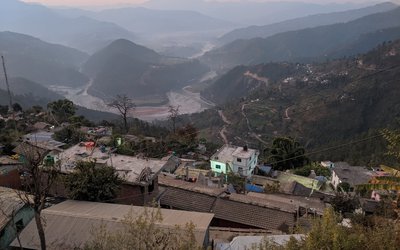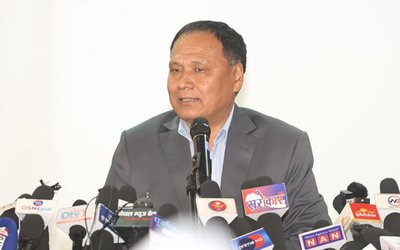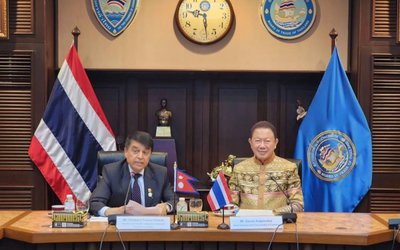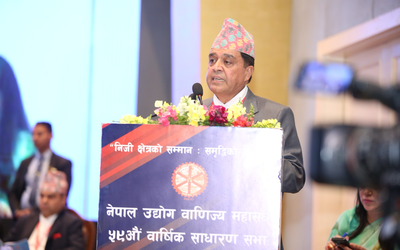
The eastern industrial section of the Dubi Corridor experienced some power supply challenges in the first and second weeks of April. Even after the power was back on, a number of dealers and business owners with vested interests flocked to the street to fish in trouble water. However, it was foiled following the restoration of electricity to the region.
The eastern region's electrical supply was impacted by both a sharp decline in power generation at hydroelectric facilities—by roughly three-quarters—and technical problems with transmission lines. Even though NEA swiftly corrected all the issues, several vested interest groups that are personally predisposed against NEA's MD Ghising started to stir up trouble. When the agitation ended in failure, MD Ghsing, who has been successfully managing NEA and Nepal's power system, restored the electrical supply.
"It is anticipated that the pre-monsoon season will begin in the coming days, which will probably result in a rise in the river's water flow. As a result, there will be a rise in electricity production, with excess electricity beginning to be shipped to India in mid-May. The managing director of NEA, Kul Man Ghising, stated that "We hope to export about 1,200 megawatts of electricity this year and have already submitted a list of programs to the Indian authorities for approval for export clearance."
The demand of Eastern Region
With Duhabi Grid's 160 MW, Damak Anaramani's 80 MW, Lahan 35, Mirchaiya 35, and Rupni 30 MW, there is more than 340 MW of demand in the east. However, there is only 30 MW of production.
For instance, 200 MW generation capacity projects are running in the East's Kabeli Corridor, but as of the end of April, they were only generating 30 MW.

Dudhkosi Solu is only supplying 27 MW in the Solu Corridor while having 86 MW of capacity. Despite having a 23 MW installed capacity, lower Solu is only producing 6 MW.
269 MW of power were delivered to NEA's eastern sector, including 200 MW from Dhalkebar, 132 kV East-West Transmission line, 30 MW from Kabeli Corridor, 31 MW from Solu Corridor, and 8 MW from Kosi Corridor.
There is a need for 80 megawatts of energy in the Anarmani area to Damak in Jhapa alone, as demand of electricity is rising throughout all of Nepal. The NEA is running the Kulekhani reservoir at full capacity around-the-clock to meet the current demand. Additionally, due to insufficient domestic output, 500 megawatts of power are imported on a daily average.
Despite having a combined installed capacity of almost 200 megawatts, the run-off-the-river hydropower plants in Taplejung, Panchthar, and Ilam are now only producing and transmitting 30 megawatts of electricity over the Kabeli Corridor transmission line.
Because there were no showers or snow this winter, the nation's potential for hydroelectric facilities to produce energy based on river flow during the dry season declined by 30% this year.
Even though most industries are operating as usual, more electricity is consumed than in the previous year. Additionally, the irrigation load to the east is unchanged.
As soon as the fields start to dry out, farmers water them. There are 80 to 100 MW needed for irrigation throughout the nation. Rain eliminates the irrigation load, allowing the industry to use that electricity. The irrigation load alone in the east is 45 MW.
Since the snow started melting and rain is falling over the past few days, those plants power generation has increased. According to their needs, the industries are now regularly supplied with power, according to MD Ghising.
According to the Hydrological and Metrological Department, the pre-monsoon will begin by the first week of May. Following that, both the river's water level and its output of energy will rise. Additionally, NEA intends to begin sending excess electricity to India beginning in the first week of June.
The NEA reports that in April, the system's peak electrical demand reached 1,750 megawatts. The base demand is 1,275 MW, with an average demand of 1,300 MW.
With the exception of the NEA's power plants, only 14% of the installed capacity is produced by hydropower facilities in the private sector.
However, NEA has made it apparent that the issue with the availability of power in places like the Koshi Province's Sunsari Morang Industrial Corridor is a temporary one.

Protest Of Vested Interest
A group of industrialists, some of whom are NEA defaulters, made an attempt to cause chaos at a time when NEA management was making plans to put an end to the disruption, supported by former NEA senior officials who supplied electricity to industries while cutting power to general consumers. They did this by blaming NEA's MD Ghising alone for the diminishing water supply.
"Rather than being driven by economic or commercial interests, the traders''movement' appeared to be politically planted. Because of electrical generation failure, power supply disruption is a common emergency. When it rains in the winter in Kathmandu, the transformers blow out. When the temperature rises in Terai, the load increases, and when the river is dry, the electricity decreases, according to Bikash Thapa's online E-kagaj.
The demand for electricity in Terai rises as the temperature rises. The load increases from fan to irrigation to industrial regions. A conductor will break, the device will catch fire from excessive strain, and a low-voltage light will turn on. The eastern region experienced the same event, according to Thapa.
Need Storage Project
The Kulekhani reservoir project is the only one the government of Nepal has constructed in the previous forty years. The current pillar of the energy sector is NEA's own, naturally-based power plants. During the harvesting and drying procedure, these power plants are somehow keeping the supply level constant.
Despite having a total installed hydroelectric capacity of 2250 MW, Nepal only generates about 1000 MW in dry session. Out of this, NEA's plants are producing 700 MW, although the linked capacity of the private sector is just 15% or roughly 300 MW.
Although hydropower projects' installed capacities rose this year, MD Ghising noted that production could not rise during the dry session because there was neither rain nor snow.
Studies have shown that Nepal is one of the most vulnerable countries in terms of climate change and Nepal will have to face extreme weather with high-intensity of rain, hot weather, and drought and so on.
With the water level in the river uncertain, the cycle of rapid increase and decrease of electricity generation is going on. As the flow of the water decreases, the production of electricity also declines.
Lack of Transmission

Transmission lines and distributions line are prerequisites to increasing domestic consumption and maintaining power supply. In order to increase internal consumption, transmission lines are needed to improve the existing electricity load.
MD Ghising has been checking and clearing the impediments at numerous transmission building sites since the first day of his second tenure. MD Ghising has been able to remove obstructions from various transmission lines, notably the 220 kV Bharatpur New Butwal, during his one-and-a-half-year tenure.
This year's electricity shortfall in the eastern industrial corridor is caused by a lack of transmission lines as well as a lack of storage projects and climate change. Kaligandaki's electricity cannot be sent from Butwal to the east or from Dhalkebar to Inaruwa without a higher voltage transmission line.
Dhalkebar also connects Upper Tamakosi (456 MW) and other power plants. Even the transmission line needed to move too much electricity from Dhalkebar to Birgunj does not exist. It is difficult to transport more than 240 MW from Dhalkebar to Birgunj and Inaruwa using the current 132 kV transmission line.
In order to avoid issues similar to the current one in the summer of next year, MD Ghising stated that the building of the Hetauda-Dhalkebar-Inruwa 400 KV transmission line and the Hetaunda-Bharatpur-Bardghat-New Butwal 220 KV transmission line is being completed as soon as feasible.
According to MD Ghising, once these lines are finished, there won't be any issues with the transmission lines carrying electricity from Dhalkebar to the east and west.
A significant amount of the barriers placed in the Heatauda- Dhalkebar- Inaruwa transmission line have been removed as a result of the top court's judgment and MD Ghising's rounds of conversations with locals, politicians, and bureaucrats. There can be no reliable supply of electricity in the east until this line is finished. Regardless of how loudly business leaders yell and protest.
Ghising stated that the construction of the Dhalkebar-Inaruwa 400 kV transmission line and the Hetauda-Bharatpur-Bardghat-Naya Ghising said that work on the Hetauda-Bharatpur-Bardghat-Naya Butwal 220 kV transmission line and the Dhalkebar-Inaruwa 400 kV transmission line is already underway, and they are working to finish them as soon as possible in order to avoid any potential problems during the coming summer. He continued by saying that there won't be any problems with the transfer of power from Dhalkebar to the eastern and western regions once these transmission lines are finished.

Hotwire, tripped breakers, and load fluctuations can all result in significant disturbances. Once the breakers tripped, the lines were cut. Reconstruction and change will take time. The industrialists complained that energy was not purposefully delivered to the sector despite these technological issues.
Politics-Driven Agitation
Numerous people believe that the recent unrest in the eastern region against NEA for failing to provide electricity is politically driven. "Some enterprises took the 'dedicated and trunk' line and kept people's houses in the dark in cooperation with some dishonest NEA personnel. People did not protest that we had to live in the dark due to the industry at the time, according to journalist Bikas Thapa's article in e-kagaj.
"Instead, they sat down. The inaction and disorganization of the authorities did not mean that snow did not fall on the mountains. The snow did not fall and did not melt and the water in the river has dried up because of Kulman. Our industrialists should know - apart from Bhutan, which country in South Asia has a 24-hour electricity supply? What is the condition of electricity in Bangladesh, Sri Lanka, India, and Pakistan?" asked editor Thapa.
The entire country is affected by this issue, not just the eastern part. Only 10 trillion rupees will need to be spent on transmission lines and substations to efficiently distribute electricity across the nation. Without investment, no transmission line will be built. It is clear how the government is doing. There is a circumstance where the employees are unable to consume their pay and benefits. The three billion rupee revenue for this year was not increased. For the government, investing in broadcasting infrastructure has become a pipe dream.
The money that NEA has made the leaders envious. Only if the authority has the financial wherewithal will the investment be undertaken. All public institutions, except for the authorities, are in ruins.
The NEA has made money, decreased leaks, and halted load shedding, yet some retired senior officials with the NEA are unhappy. Because they were unable to exterminate flies at the time. The days of giving the industry control while taking commissions, accepting bribes when moving staff, and requiring commission in contracts are long gone. Reduce the loss from where the leakage is coming from. The population has gradually emerged from the shadows. However, that class is not content, according to journalist Thapa.

That class is so thrilled when load shedding continues, when power leakage increases when losses mount when electricity must be imported from India. Their search is therefore restricted to a hole in the sesame field. Those who have studied and worked for the authority all of their lives and identify as electrical engineers are irate at its growth and development, but they continue to receive pensions from it. The purported relocation of businessmen in the eastern region is what the class finds frustrating, according to Thapa.
Power supply interruptions will continue to happen in the eastern area of Nepal since its hydropower plants are dependent on the run-of-the-river scheme—especially during the dry season. The electricity supply will be consistent as the 400 kV Hetauda-Ddhalkebar-Inaruwa transmission line construction is nearing completion.
"The recent movement against MD Ghising is deliberate and driven by politics. Why criticize MD Ghising, who changed the course of Nepal's power supply and made industrialists wealthy? By efficiently regulating the electric supply, MD Ghising made a significant contribution to the end of load shedding. In the current situation, when the snow has not yet begun to melt, power scarcity is natural. Ghising's lack of water is not her fault. He is not at blame for failing to produce electricity. Thapa questioned, "Most of the industrialists from Biratnagar are defaulters and have bigger debt.
The power supply problem in the eastern industrial zone was improved because of MD Ghising's participation. An attempt by special interests to undermine the NEA fails miserably.

- NEPAL-THAILAND: Joint Business Council
- Apr 13, 2025
- BIMSTEC SUMMIT: Nepal’s Stand
- Apr 11, 2025
- IME GROUP: Expands Into Paper Industry
- Mar 24, 2025
- CPN UML: Instigated By India
- Mar 23, 2025
- ADB’S CHIEF ECONOMIST: Nepal Reduces Poverty
- Mar 11, 2025















